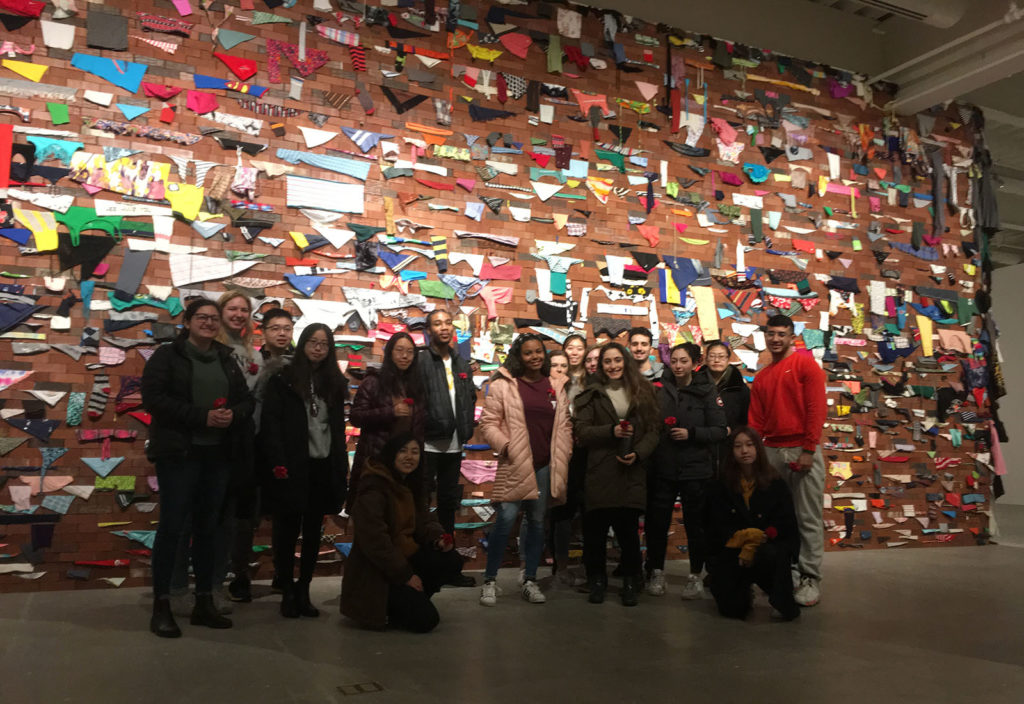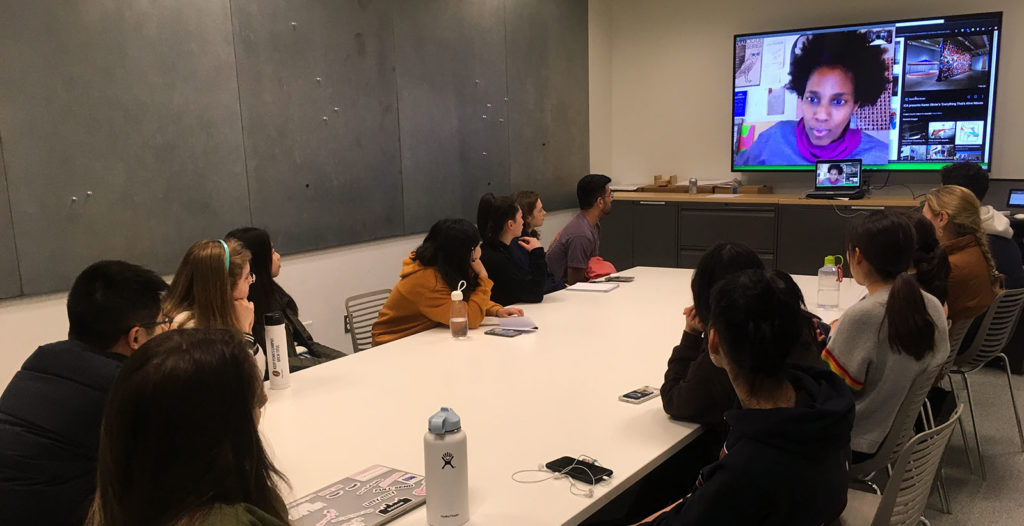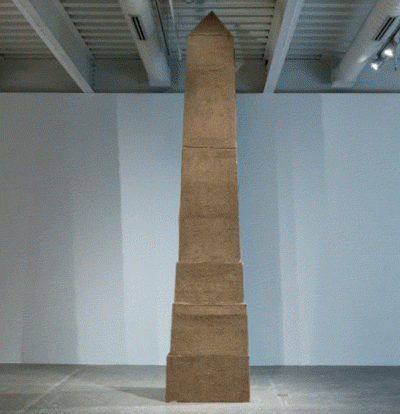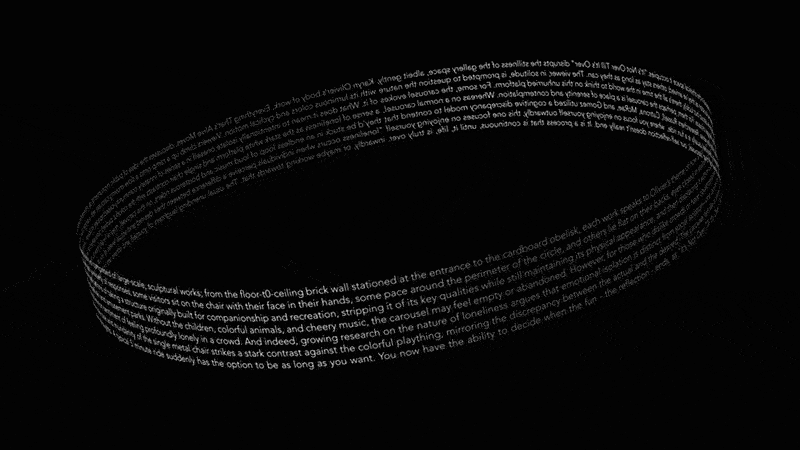- Introduction
- Rethinking Monumentaliy in May 12, 1985
- Invisible Efforts
- Idea: Obelisk represents a community’s drive to survive no matter where it is
- The Unsteady Stability of the Monumental Obelisk
- It’s Not Over Till It’s Over
- Conclusion

1. Introduction
by Avery Lawrence
“Let’s co-write a response/review/reflection in reaction to our experiences with the exhibition Karyn Olivier: Everything That’s Alive Moves at the Institute of Contemporary Art.”
I said that or something like that to 18 University of Pennsylvania students in January of 2020. Thus began an experiment in collaborative art writing. Instead of attempting to emulate a professional art-writing style, the idea was to embrace our amateurishness as we co-crafted an unimpeded – and, maybe, unexpected – written response that reflected our ideas and feelings about an art show. As a class, we had various encounters with Olivier’s work over the course of the semester: I encouraged the students to attend the Opening Celebration at ICA on January 24, 2020; on February 13 we visited the exhibition as a class, spending 45 minutes with the work; and on February 18 we chatted with Karyn Olivier over Skype.


The format of this collaboration was loosely structured. In the gallery, surrounded by Olivier’s art, the students let their interests take them to a specific piece. There they encountered like-minded peers. The five groups that emerged from this globbing activity then worked together – in person and in a shared digital document – to craft one written response. In the words and links and images and gifs that follow, you will find 18 students responding to art together.

2. Rethinking Monumentality in May 12, 1985
by Alexa Cotler, Leora Korn, Riley Wesolowski & Kevin Xu
Perhaps the most common notion of a monument is as follows from the Oxford English Dictionary: A statue, building, or other structure erected to commemorate a famous or notable person or event. And yet, in Karyn Olivier’s recent solo exhibition at the Institute of Contemporary Art, Everything That’s Alive Moves, the definition of a monument is stretched to its ideological limits in the meaningful and sentimental piece May 12, 1985.
Situated in West Philadelphia, the geography of ICA takes on a vital role in May 12, 1985, as the titular date alludes to the day before the fateful 1985 MOVE bombing, which took place on the 6500 block of Osage Avenue. May 12, 1985 also happened to be Mother’s Day – of which the red carnations are a symbol. In this way, the carnation is its own monument, breaking down the idea of macrocosm and structure in favor of microcosm and token. The symbol of the carnation, though having this origin in the mind of the artist, is received by the viewer in any number of ways. Carnations lend themselves well to a distinct type of polysemy; they are a common symbolic gesture for all different kinds of cultural phenomenon. The viewer brings to this piece their own particular histories and perceptions of the flowers, producing a uniquely viewer-oriented monument.

3. Invisible Efforts
by Jen Gliklich, Aden Horowitz, Omar Swidan & Tyler Wilson
Our group was particularly fascinated by two of the works: a brick wall with articles of clothing used for mortar, and an Audi seemingly built from shoes. We struggled to understand them in the context of Karyn Olivier’s theme of monumentalism and it sparked a lot of interesting debate and conversation. Both pieces include personal items that are buried, but partially exposed. This gave us the idea that Olivier meant to expose unrecognized labor efforts undertaken by people who cannot afford the products they create, such as nice cars and large properties (the Audi and the wall). Connecting to Olivier’s theme of monumentalism, monumental structures generally pay homage to events, efforts, or people who an artist believes need not to be neglected.
We compared the two monuments to Oscar Murillo’s A Mercantile Novel which presents viewers with images and videos of migrant laborers working on assembly lines in a chocolate-covered marshmallow factory exhibit in New York. Like Olivier, Murillo sought to pay homage to the efforts of workers who he believed should not be forgotten by society. In his work, he emphasizes the idea of separation and familial hardships that come as a result of tumultuous work in factories. Some examples of his work are a painting of his mother sleeping on the assembly line, a video of the airplane bringing factory workers to New York, and his father’s certificate of employment.
During our video call with Karyn Olivier, we realized that the work actually had nothing to do with specifically recognizing labor efforts, but rather putting a spotlight on underappreciated public objects and monumentalizing present-day life as a whole. Her work brings out emotions in viewers that are connected to objects we experience on a regular basis, like a car or a wall, and helps us to recognize the significance within these seemingly insignificant structures.
After the call, our group discussed that regardless of the alignment or misalignment between our original interpretation and her intent, both interpretations aim to crack and unveil the invisibility of our surroundings. From this experience, our takeaway is that we should pay attention to the world around us and our connection to it, and to recognize the significance of little things that typically live in shadow.

4. Idea: Obelisk represents a community’s drive to survive no matter where it is
by Cindy Chen, Abdel Hubbi, Amy Miao & Nicole Ng
According to an in-exhibition video, Olivier covered the outside of the obelisk with the dirt and sand that she had dug herself in Rome. Although the obelisk is an inanimate object, it has been endowed with life through the layers of earth that cover its exterior. No matter where the obelisk is physically relocated, it always carries these layers of life with it.
What is also interesting is that Olivier juxtaposes the idea of being temporary to the withstanding effect of a monument. She uses cardboard material to create the obelisk, however, the cardboard appears to be something of higher structural integrity. This phenomenon could stress the meaning of a strength of a community no matter the countless struggles of discrimination or relocation.
Similarly to Olivier’s obelisk, which was deconstructed in Rome and reconstructed in the exhibition, the same concept of relocation can be applied to the Native Americans of Minneapolis. Even after Native Americans were forced to move from their reservations to urban areas due to the Indian Relocation Act, the new communities established are still representative of Native American culture. Despite facing issues such as poverty and drug addiction, they’re a resilient group that continues to fight in hopes of a better future.
Another interesting connection to bring up relating to Olivier’s obelisk and the theme of community is that of the “Cult of the Lost Cause” movement, in which confederate memorials were built and maintained by organizations such as the United Daughters of the Confederacy. One of the most prominent memorials is the Jefferson Davis Monument, a 351ft concrete obelisk marking the birthplace of the Confederacy’s only president in Fairview, KY. This relates to the Native American article, as it conveys how a community, no matter how opposed or diminishing, will fight for their continued existence.
5. The Unsteady Stability of the Monumental Obelisk
by Sofia de Guzman, Lily Huang & Desiree Izecksohn
“Maybe monuments can be instruments that offer us a mirror to give witness to ourselves, our community, or to the world. Or maybe they implore us to be aware of the present moment and allow us to reflect on our shared complicated histories.” – Karyn Olivier
Karyn Olivier’s exhibition, “Everything That’s Alive Moves”, is composed of several intricate pieces that say a lot about not only who she is as an artist, but also gives insight into her ideas and thoughts as a 21st century citizen. One sculpture that caught our eye is the Obelisk, and how it is accompanied by a video showing the process of building and transporting it. The fact that she chose to display this is quite interesting, because there is a lot of speculation about how the ancient obelisks in Egypt were erected. It is known that they were carved out of stone, which Olivier attempted to represent, and that they were sacred objects that symbolized the sun god Ra. However, there is no real knowledge of how those heavy stones were lifted several feet into the sky.
Karyn Olivier’s Moving the Obelisk, features a full-sized obelisk alongside a video detailing its migration from Olivier’s studio in Rome to the Institute of Contemporary art in Philadelphia. Research into the obelisk’s origins reveals that the meaning of the monumental obelisk has oscillated since it was first created by the ancient Egyptians in 2500 BCE. Thus, the monumental obelisk should be viewed as a dynamic object that narrates an amalgamation of complicated histories.
First when looking at the sculpture, it gives a sense of heaviness to the audience. I would imagine that the sculpture is made out of rocks just like the Egyptian Pyramid, without any connecting substance serving as the “glue”. After watching the process video of this sculpture, we found out that it is actually made out of paper boxes. I felt quite uncomfortable with the unbalance between the emotion it gives me and the material it is made of. On top of this, we felt like the existence of nails really interrupts the historical sense of this form. But the color is well chosen to be the rock color to fit the form.
The form of it being rock-like contributes to its identity as an obelisk. An obelisk is a type of boundary marker, differentiating itself with other boundary markers in being a tall, four-sided, narrow tapering monument that ends in a pyramid-like shape at the top. It definitely originates from the ancient Egyptians and Greek culture. Originally, it was usually set on a base, for commemoration of someone in the honor of the god—it symbolizes the sun god Ra.
Nowadays, obelisks are built for the purpose of being landmarks, as memorials of a specific event or person in similar fashion as the ancient times. For example, The Washington Monument was an obelisk, built in the shape of an Egyptian obelisk, representing the timelessness of ancient civilizations, showing the respect and gratitude the nation felt for its most essential Founding Father.
Olivier attempts to show that the monumental obelisk has deteriorated. Unlike the typical obelisk carved from a single stone, Olivier’s is constructed in segments of cardboard, dirt, and wood held together by tape and glue. This represents the fragility of the obelisk as a monumental form. The ancient Egyptians first created obelisks around 2500 BCE and erected them in pairs at temple entrances. While obelisks were primarily monuments that revered the sun god, Ra, they also memorialized the dead and commemorated the pharaohs. Around 30 BCE, ancient Roman emperors began to conquer Egypt. During their ransacks, the Romans stripped several obelisks from Egyptian temples and shipped them to Rome where emperors erected these abducted obelisks in public squares and rededicated them to the Empire’s “successful” conquests. In the 11th century, many of these obelisks were knocked down; however, the rise of the Roman Papal States after 1587 led to a string of obelisk excavations and restorations. These obelisks were, again, erected in public squares and served to memorialize Rome’s “triumphant” past. Ultimately, the Romans conquered not only Egyptian territory but also culture as they appropriated the monumental obelisk. Olivier’s video touches on how people can project their own ideologies on a monument and cause a divergence from a its original meaning. By dismantling, relocating, and reassembling the obelisk, Olivier suggests that the significance of the obelisk as a monumental form is not as concrete as generally supposed.
6. It’s Not Over Till It’s Over
by Jada Harrison, Maxine Fang & Cynthia Zhou

Karyn Olivier’s body of work, Everything That’s Alive Moves, discusses the idea of public monuments as inherently tied to memory. The exhibition is comprised of large-scale, sculptural works; from the floor-to-ceiling brick wall stationed at the entrance to the cardboard obelisk, each piece speaks to Olivier’s theme of how a community’s public memory is imbued in the physical space it occupies.
“It’s Not Over Till It’s Over” disrupts the stillness of the gallery space, albeit gently, with its luminous colors and cyclical motion. Viewers climb up a ramp onto a slow-moving carousel with a single chair. The same space prompts a variety of responses; some visitors sit on the chair with their face in their hands, some pace around the perimeter of the circle, and others lie flat on their backs, eyes closed in solitary contemplation. Some descend as soon as they’ve arrived; others stay as long as they can. The viewer, in solitude, is prompted to question the nature of it. What does it mean to intentionally isolate oneself in a series of innately community-based spaces (museum, university)? What are the implications of taking a structure originally built for companionship and recreation, stripping it of its key qualities while still maintaining its physical appearance, and then displacing it within a gallery setting? It’s a lot to think about; but luckily, there’s all the time in the world to think on this unhurried platform.
For some, the carousel evokes a sense of loneliness as the stark white platform and single chair contrasts with the colorful packed carousels that are traditionally found at festivals and amusement parks. Without the children, colorful animals, and cheery music, the carousel may feel empty or abandoned. However, for those who dislike crowds or have claustrophobia, the carousel is a nice change of pace. For them, perhaps the carousel is a place of serenity and contemplation. Whereas on a normal carousel, they’d be stuck in an endless loop of loud music and boisterous riders, on this carousel, they’re finally free to think.
Olivier speaks to the common sentiment of feeling profoundly lonely in a crowd. And indeed, growing research on the nature of loneliness argues that emotional isolation is distinct from social isolation—one can be alone but not lonely, and vice versa. Researchers Russell, Cutrona, McRae, and Gomez utilized a cognitive discrepancy model to contend that “loneliness occurs when individuals perceive a difference between their desired and actual levels of social involvement”. In Olivier’s piece, the size and mundanity of the single metal chair strikes a stark contrast against the colorful plaything, mirroring the discrepancy between the actual and the desired.
The carousel felt like a place of reflection. Whereas a carousel usually is a fun ride, where you focus on enjoying yourself outwardly, this one focuses on enjoying yourself inwardly, or maybe working towards that. The usual unending laughters of yourself and others are now gone, leaving you with your own thoughts. A typical 5 minute ride suddenly has the option to be as long as you want. You now have the ability to decide when the fun – the reflection – ends, as “It’s Not Over Till It’s Over”. But even when one comes off that carousel, our self-reflection doesn’t really end. It is a process that is continuous, until it, life, is truly over.

7. Conclusion
by Avery Lawrence
I’ll end with gratitude. Thank you to Cindy, Alexa, Sofia, Maxine, Jen, Jada, Aden, Lily, Abdel, Desiree, Leora, Amy, Nicole, Omar, Riley, Tyler, Kevin and Cynthia for working together and sharing your thoughts and words about art. Thank you to the Institute of Contemporary Art at the University of Pennsylvania for your exhibitions and programming. And, most of all, thank you to Karyn Olivier for sharing your time and your work.